What is boss design?
Boss design is the process of creating a climactic encounter in a game.
There’s a carefully balanced mixture of challenge, cinematic appeal, narrative anticipation and mechanical consistency that goes into every fulfilling boss battle.
As the Design Director of The Mageseeker: A League of Legends Story, I had the opportunity to design many and varied boss battles, and I’d like to share what I’ve found to be the most important parts of the process.
(Because, no, it’s not as simple as putting a giant frog at the end of Normal-Sized Frog Cave.)
So, at this point, you might be wondering…
What is a boss, anyway?
When you think of a boss, you might imagine a big, bad creature that’s going to kill your character(s) many times before you defeat it.
Depending on the game, though, bosses can serve many different purposes!
They can be anywhere from tiny to huge, some aren’t actually evil, and many bosses aren’t creatures at all (even if they might look like it).

That said, most bosses—independent of the type of game—are…
- Challenging: A boss doesn’t need to be extremely difficult, but they should always test the player somehow, usually relating to their moveset. If there’s no challenge, what’s the point?
- Climactic: Usually, bosses are found at the end of a distinct section of the game (like a specific level). They represent the peak point of tension in the pacing structure.
- Blocking You: Bosses usually gate the player from reaching something they want. This can be story or game progression, a piece of gear, a collectible, a new area…
Breaking down the anatomy of a boss
When you think of a boss, you might immediately think about fighting it.
Although that’s probably the part with the highest impact (and longest development time), a well-designed boss needs each of these aspects:
Anticipation
Players want to know a boss fight is coming. How long this anticipation should last depends on how relevant the boss is.
Many games introduce you to the main villain early on. You know you’ll fight them eventually, so the whole game builds up to that moment.
Some memorable examples of this are Ganondorf in The Legend of Zelda: Ocarina of Time and the giant Sin from Final Fantasy X (looming over Tidus below). Both games’ main plotlines are about getting ready to fight these final bosses.
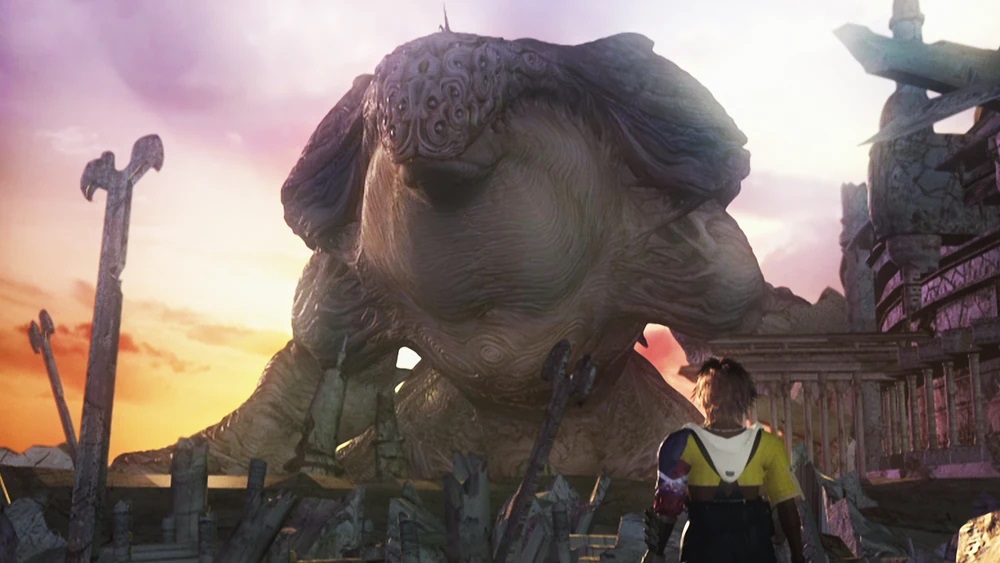
However, it doesn’t always need to be that long or elaborate. Sometimes, the anticipation comes just a few minutes or even seconds before the fight—and that’s fine!
This can be accomplished with a long corridor, a circular room, or some other clear alteration to the environment.
For example, in The Mageseeker, we hinted at the Polar Lizard by adding more and more ice to warn the player they’re heading into a boss area:

Obviously, the more work you put into the anticipation, the more exciting the boss fight will be—but sometimes, just having a checkpoint in front of a big empty area is fine!
Presentation
So, you’ve reached the boss area—but it’s not time to fight the boss yet!
Every memorable boss has an awesome presentation. This is where we get to see why the boss is a threat to us and what makes it unique.
Normally, this is done through a cutscene. AAA games put tons of effort into the presentation of their boss battles, but you can still create a fun and imposing boss without spending half your budget.
For instance, take the smart and impactful presentation of Sans in Undertale. It’s just a light talk, with no music. This builds to the moment where you read, “You feel like you’re going to have a bad time” followed by the Megalovania theme.
This moment lives rent-free in the minds of everyone who did the “genocide” route in Undertale:
The fight!
This is the main dish of a boss. Anticipation and presentation are the promise of the boss fight, and now you have to meet the player’s expectations.
Did you present your boss as the strongest character in the game world? They’d better be challenging and scaled properly!
For instance, does the boss have a gun? Well, then they should actually use it, or else your players will be confused.
This is a mistake we made in The Mageseeker. We designed the Polar Lizard fight around him not being able to move, but he ended up having big paws (as you can see below), so we iterated the fight to meet those expectations—and playtesters had a better experience with him:
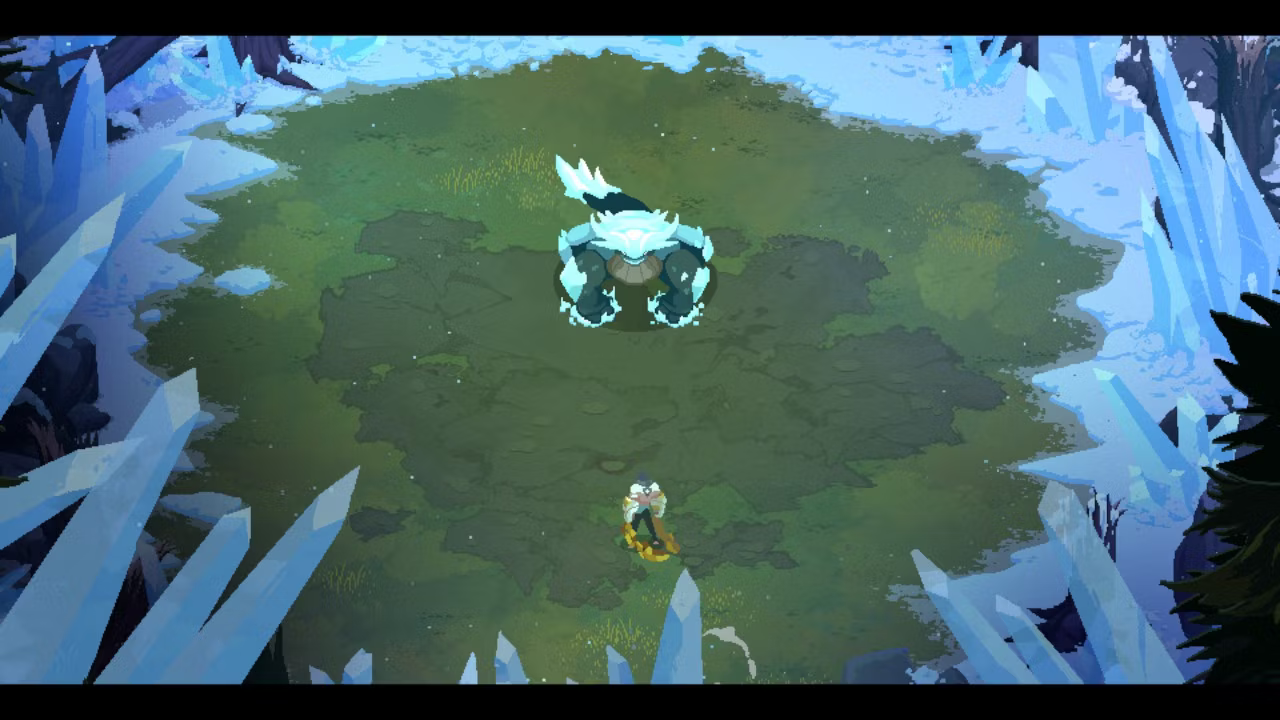
Developing the fight itself is a huge task that’s normally subdivided into different phases. It’s also the aspect of boss design that takes the most resources to develop.
Conclusion
That’s it! You beat the boss!
Remember, a boss is a challenge, an obstacle, and a climactic part of the game. The player worked hard to arrive here. Let them celebrate!
Obviously, a cool cutscene is always nice, but don’t forget to reward the player. The reward should match the challenge of the boss.
For example, in Another Crab’s Treasure, Grovekeeper Topoda is a difficult optional boss, but defeating him unlocks a powerful new ability:


The boss also becomes an NPC that can improve your existing abilities, which feels really satisfying after being killed by him 30 times.
Which game genres have boss battles?
When we think about bosses, we tend to think about action/adventure games, but almost any genre can include boss encounters.
Platformer bosses
Some noteworthy examples here are Bowser in Super Mario Bros. or Badeline in Celeste (below):

In side-scrolling platformers, bosses are mainly player skill tests—they don’t ask you to do anything new, but to do the same thing (e.g. jumping) with precise timing while avoiding a threat.
Puzzle game bosses
GlaDOS in Portal is one of the most popular bosses in video games. Cocoon also has boss fights that focus on pacing changes, like Crystal Moth:

Normally, you have plenty of time to make decisions in puzzle games, but bosses like this one force the player to execute specific actions while evading changing crystal patterns.
Deck-building game bosses
These types of games are about, well, building a deck, so bosses in these games focus on defying the player’s build. For example, Slay the Spire and Balatro both have bosses like this:

Usually, even if you have a unique strategy, you’ll end up fighting a boss that counters it.
First-person shooter bosses
Doom Eternal and Titanfall 2 both place bosses at the end of each section of the game, like this midair battle against Viper in Titanfall 2:

FPS bosses tend to be both skill tests and a celebration of explosions and FX that would get any player’s blood pumping.
Boss rush game bosses
Of course, these place extra importance on the boss fights—and they’re constant skill tests. Both Titan Souls and Fury give the player a straightforward moveset but make each boss unique and unpredictable, pushing the player to master the basic mechanics:

Almost any genre where you want to challenge the player can have a boss fight!
But, this doesn’t mean you should add one at every opportunity. Knowing when, where and why to include a boss will help make each boss encounter more memorable and avoid having the team work on unnecessary content.
Plus, there are other ways to create tension in a game that don’t depend on a boss.
One easy way to do this in an action game is with repeating waves of enemies. The challenge of managing so many enemies at once can be just as intense and fun as an exaggerated boss battle.
I was impressed by what Transistor did in one of its levels. When I arrived at the place where I was supposed to fight the leaders of the evil organization, they were already dead. I don’t remember any boss fight from Transistor, but I do remember that impactful moment:
So, you don’t always need a boss to create a climax—but no one can deny that they’re an excellent tool for it.
The 4 key principles of boss design
Before you start designing your boss fight, keep in mind that all bosses should follow these core principles:
1. Purpose
First, determine the main reason you’re making this boss.
What kind of experience are you planning for your players? You need to understand your objective with the boss fight and make sure everything you create serves this purpose.
Boss fights have two main purposes (which can also be combined):
Skill Test: These types of bosses are very common and have some familiar variations.
You might want to test whether the player has mastered a specific skill that’s important for the rest of the game.
This is the case with most bosses in old Zelda games, like Gohma in Ocarina of Time. The goal here is to make sure the player can use the slingshot to hit the boss’ conspicuously glowing giant eye:
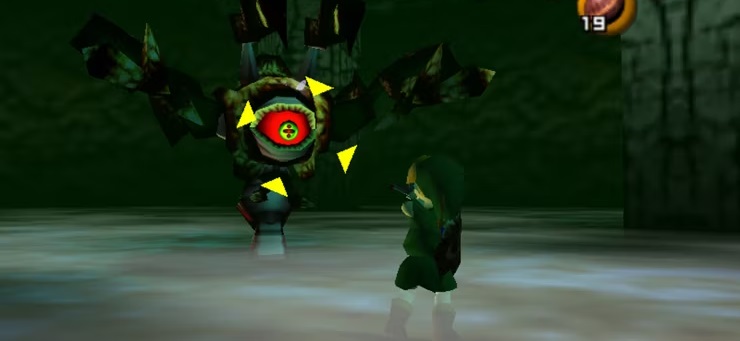
In The Mageseeker, we made the player face Giant Helm, a boss that constantly changes from an ice to fire nature, to make sure they understood elemental weaknesses.
It’s a pretty straightforward and even easy fight once you understand it, but it’s useful for making sure players don’t progress to the harder content without understanding a vital game mechanic.
Here’s how to handle the Giant Helm fight (spoilers, by the way!):
Another approach is to check the player’s mastery of their whole moveset. This is probably the most common type of boss fight.
How difficult these fights are will depend on the game and your target audience. If you are making a game that is meant to be challenging, like Dark Souls, bosses will be quite demanding.
On the other hand, we have games like Kingdom Hearts, with bosses designed for a wider audience—still challenging, but much more manageable, like Trickmaster:
You can also add options for players to adjust the difficulty. Or, there’s my personal favorite: optional boss fights, like Sephiroth’s appearance in Kingdom Hearts, which can satisfy the hardcore fans without gatekeeping more casual players.
Narrative: From a narrative design perspective, sometimes you want to add a boss fight as a means to progress the story.
In games where the narrative or/and characters are important, this can be really powerful.
Sure, fighting a big, scary creature in the woods can feel great. But when the game is built to develop a personal connection with a character, then makes you fight them…that’s always a memorable boss fight. You know exactly why you’re fighting and why you NEED to win.
An excellent example of this type of fight is GlaDOS from Portal:
Portal is a puzzle game, so you wouldn’t necessarily expect a boss fight. However, GlaDOS annoys and antagonizes the player for most of the game, so of course you’ll want to strike back when given the chance.
The GlaDOS fight uses the same tools the player has been solving puzzles with for the whole game, so it’s both a narrative and skill test boss.
Once you’ve determined the overall nature of your boss fight, it’s time to decide how challenging it’s going to be.
Defining the Learning Curve: A boss’ learning curve—how long the player takes to learn their behavior and defeat them—is modeled by the theme of the game you’re making.
If it’s a family-friendly game, you don’t want your players to get stuck in a boss fight for hours. That’s why the bosses in most Kirby games are fun and usually not stressful, but still succeed in testing the player—like the Tropic Woods fight:
On the other hand, Dark Souls bosses are epic and tough. That’s the game’s promise.
FromSoftware games typically extend the learning curve of their bosses by giving them several new attack patterns to learn in each phase, so players have to repeat the bosses over and over until they master them—a familiar fate for anyone who’s fought Malenia in Elden Ring:
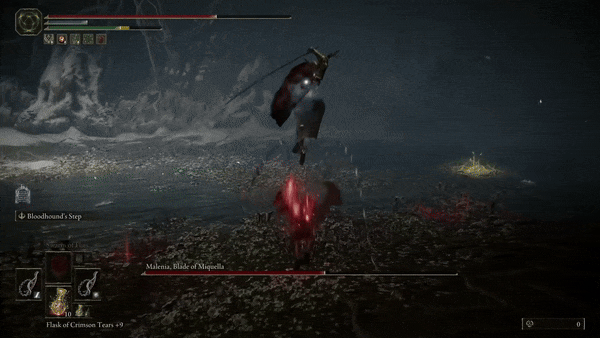
There are also several different approaches to designing how players interact with a boss.
For instance, the older Zelda games are linear adventures, based on obtaining new tools and learning to use them. The purpose of each boss is to make sure the player has mastered the new tool. They have a unique strategy and are pretty much under lock and key.
However, Breath of the Wild and Tears of the Kingdom encourage players to experiment with their new systems, and the bosses are no exception. You can engage with them whenever you want and use basically any tool in the game. Tears of the Kingdom definitely has the most unusual problem-solving of any Zelda so far:
2. Theme
Once you have an objective for your boss, you can start working on the theme:
- How does the boss look?
- How does it move?
- How can it attack?
- Where is it located?
You want your boss to be coherent. It should look like your boss has a strategic plan to defeat the player.
You also want your boss to be recognizable. Any two bosses in your game should be easy to tell apart—from their silhouette, their moveset, the arena, and the music.
A boss I recently played that nailed this is Magista, Tyrant of Slacktide, from Another Crab’s Treasure:
The first time you see her, she’s not hostile. But when you see her throne room, you know you’re going to fight; then you see her holding a tea strainer and realize that’s her weapon.
These visual cues build lots of anticipation and make the boss fight feel completely on point.
3. Moveset
Very important: at this point, the player’s moveset has to be defined.
Here are some of the most important considerations when you’re designing a moveset:
- All bosses need to be designed around your player’s moveset. If you start working on a boss before this step, it can lead to many, many rounds of iterations.
- Once you have a clear understanding of your player’s moveset, you can start to think about different attack patterns and how they’re going to move.
- The moveset will also reflect the personality/theme of the boss. For example, if your boss is a duelist, they should never spawn enemies.
- Each of your boss’ attacks should look and feel distinct, with differing ways for players to interact with them. The Mr. Freeze fight is a solid example of this (pun intended):
Of course, if the only way your character can evade an attack is by dashing, all your boss’ attacks should probably be avoidable with a dash.
But the mechanics can still go deeper. You can play with the attack timing or direction (should they dash away from the boss, or toward it?).
You can also include attacks that penalize the player if they over-rely on dashing or a particularly useful ability—like how mindlessly swinging your sword in Zelda: A Link to the Past can make Moldorm bounce you into these pits and restart the fight:
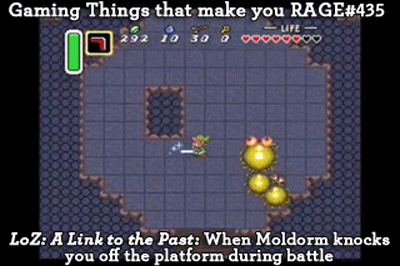
The boss’ attacks also need to be easy to read.
If you’re asking the player to react differently to each one, they all need an appropriate tell that the player can identify and respond to quickly (otherwise, the boss may feel random and unfair).
Take the bosses in Hades. They all have an incredibly well-crafted moveset with a clear visual language.
The game’s approach to enemy design is to give most enemies and bosses a noticeable tell: before they attack you, they stay frozen for several frames in a recognizable pose, and sometimes they even blink:
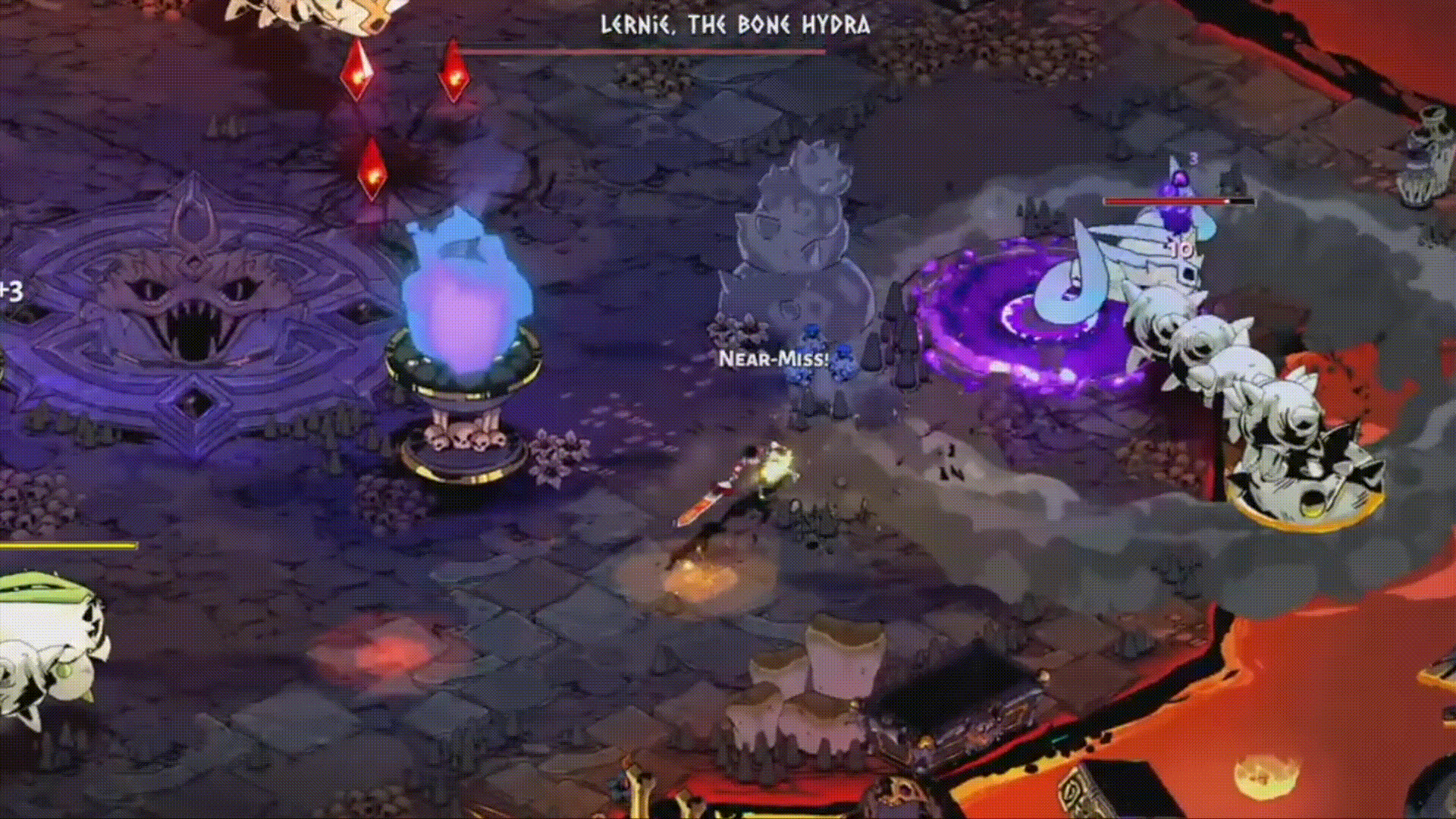
There are always many things happening at the same time on your screen, but it’s fun because the patterns are easy to read. You never feel like the game is trying to trick you.
Of course, you don’t want the player to get bored because your boss is too predictable. Adding a bit of unpredictability will keep them paying close attention, and it’s pretty cheap to do!
Here are some ways to keep your boss battles feeling fresh:
- Add variations to some attacks. If your boss primarily attacks by swinging a blade once, make it do this twice sometimes (but don’t forget to allow the player to react to this).
- Spawn enemies. Many games introduce irritating smaller enemies to keep players on their toes during a boss fight.
- Overlap attacks. If the boss has an overtime attack (like spawning areas for a few seconds), try allowing the boss to use other attacks while the sustained one is going on. (Just don’t introduce a new attack here. Overlapping attacks add noise, are hard to avoid, and aren’t the ideal way to learn new mechanics.)
- Interphases. These change the fight’s rhythm by requiring the player to interact differently with the boss. Sometimes, the boss is immune during the interphase so that the player can focus on other objectives, like destroying weak points, fighting waves of enemies, moving around platforms or just avoiding attacks.
In The Mageseeker, we learned a lot of this when designing the Garen fight:
Garen is a famous character in League of Legends and we wanted his fight to be epic, challenging and memorable.
But the first few versions were forgettable. Although the art team did an amazing job with his attack animations and cutscenes, the fight was just boring—because he was too predictable.
So, we added more variety to his moveset:
- He has one that casts a light sword from the sky (which is his ultimate in League of Legends), and we decided to push this attack during the whole fight.
- Instead of just 1, he now spawns 1 to 3 randomly and can chase the player while they’re spawning.
- Garen can also swing his sword once or twice (with a random chance of spawning a light sword during the animation) and can spawn multiple swords to cover half of the arena, forcing the player to fight uncomfortably close to him:
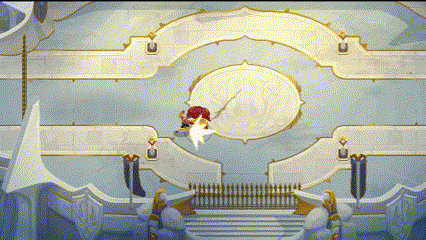
Attacks should also have visuals that match their power.
If an attack is going to one-hit-KO the player, its animation should be just as threatening. (Likewise, pairing misleading visuals with surprisingly strong or weak attacks can be irritating.)
Continuing with the Garen fight, we were scared of being too mean with the players.
Initially, his final attack had awesome visuals but did low damage. We realized it was better to make the damage match the visuals and just add a long tell for players to interrupt it.
We also made the mistake of not showing the attack if the player was able to cut it—essentially punishing their success by taking away something cool. So, we just deviated to let players see what they avoided:
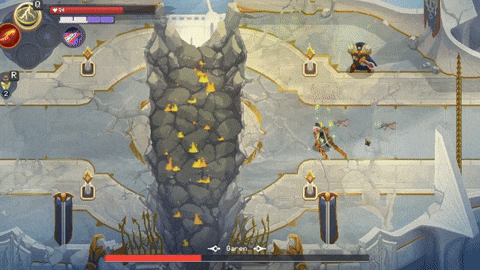
Each Garen iteration made small changes individually, but together, they really leveled up the experience. Now, we’re very proud of that fight—it’s definitely one of the best boss battles in the game!
4. Escalation
One of the most fun parts of boss design is escalation. This is normally done through phases since players will eventually get used to the boss’ behavior.
Here are some of the most effective ways to escalate a boss fight:
- Add brand new attacks
- Evolve their existing moveset by adjusting speed or range, adding elemental effects, etc.
- Alter the arena where you’re fighting (feel free to go crazy playing with the boss’ changing appearance)
- Include a cool cutscene whenever there’s a phase change.
An incredible boss fight that does all of the above is Ganon in Breath of the Wild—he changes his attacks, the arena, and his visuals, AND Link gets a horse (so even the player’s moveset changes!):
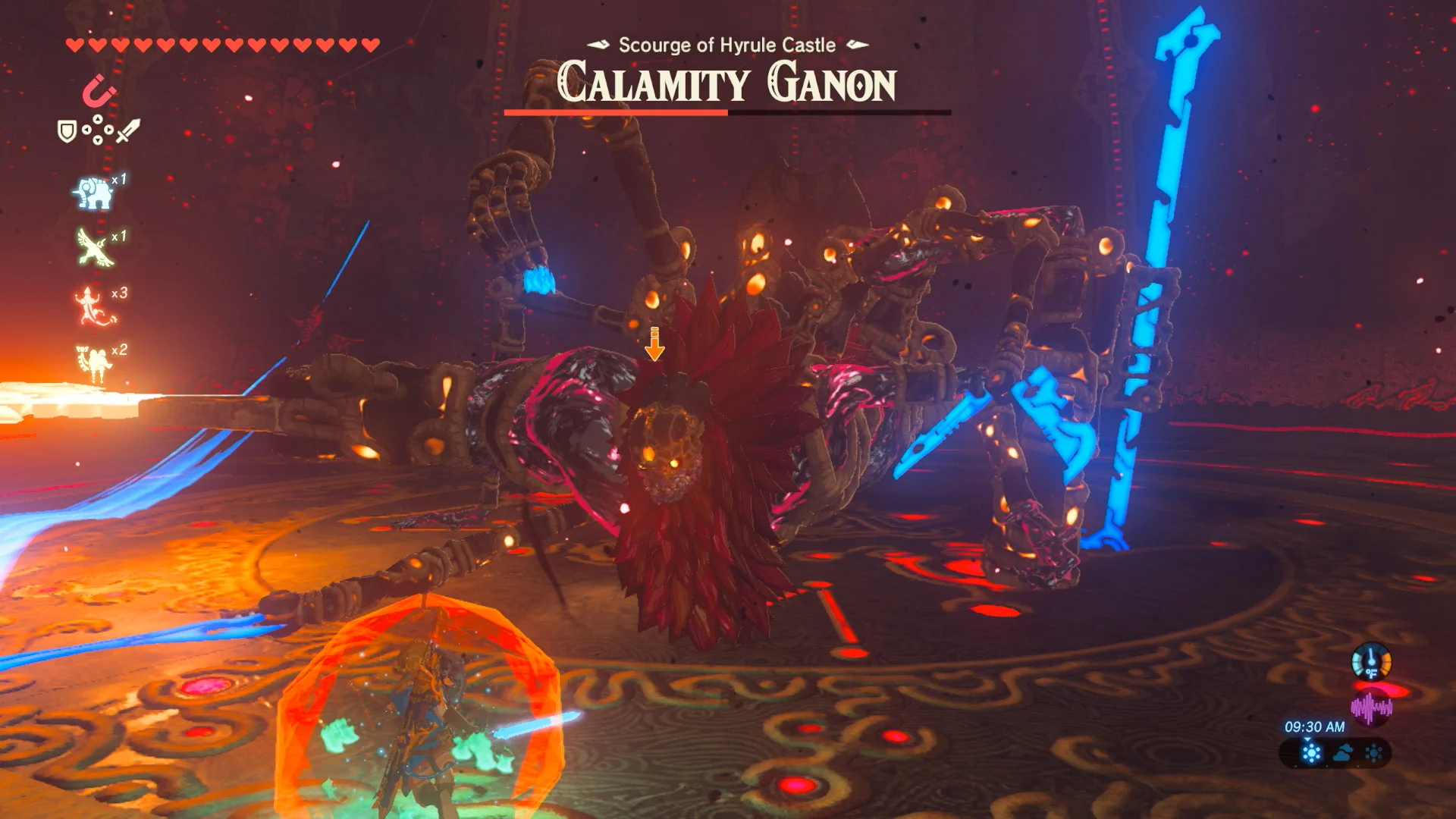
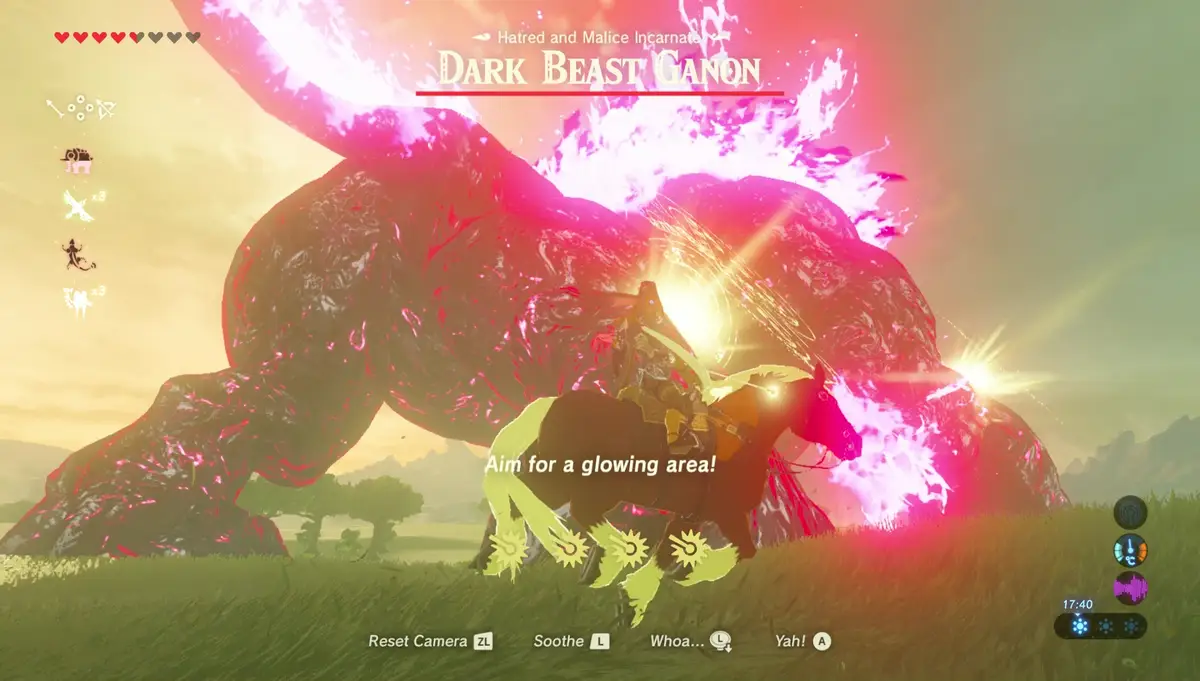
An even crazier example is Ansem in Kingdom Hearts. This boss has 10 different phases where everything changes, to the point that they each feel like separate boss fights.
Ansem was definitely tough for me as a kid (it’s a long battle with NO checkpoints!) but it’s probably one of the most memorable boss fights I’ve played:
Thankfully, there are some cheaper, clever ways to do it.
The bosses in Hollow Knight (one of the smartest games I know in every aspect) are quite simple in design terms, but they’re perfectly executed. The game doesn’t need crazy cutscenes or dozens of boss attacks to make each of them memorable.
Soul Master, for example, has two recognizable phases. The boss’ attacks don’t change a lot, but the second phase still clearly feels like an escalation of the first one:
Phases make sure players stay engaged with the fight and generally make it more epic and rewarding, but they’re expensive, so it’s important to choose the most valuable places for your team to implement them.
If a new attack (or change in the arena) affects the overall dynamic of how the player approaches combat, it will elevate everything in a very elegant way.
One example of this is Lady Maria in Bloodborne. During the first phase, she attacks the player with fast, but manageable melee attacks. In the second phase, her melee attacks get even quicker and gain a lot of range:
Players can avoid her attacks by dashing away in the first phase, but the second phase forces them to change their strategy.
8 ways to create a memorable boss fight
You’ve probably played over 100 bosses in your life, but only remember a few. And that’s totally fine.
When designing a game with bosses, you should carefully choose which ones you want to stand out. If you try to make every fight memorable, then none will be.
Here are 8 different ways to make a boss fight more memorable (feel free to mix together as many as you want):
1. Make the player care
As we discussed earlier, boss fights with a narrative component tend to be more memorable.
I already talked about GlaDOS being one of the best villains ever. Another strong example is Hades, in Hades—your father who waits for you, in what has to be an uncomfortable snowfield, just to block his own son from leaving the underworld:
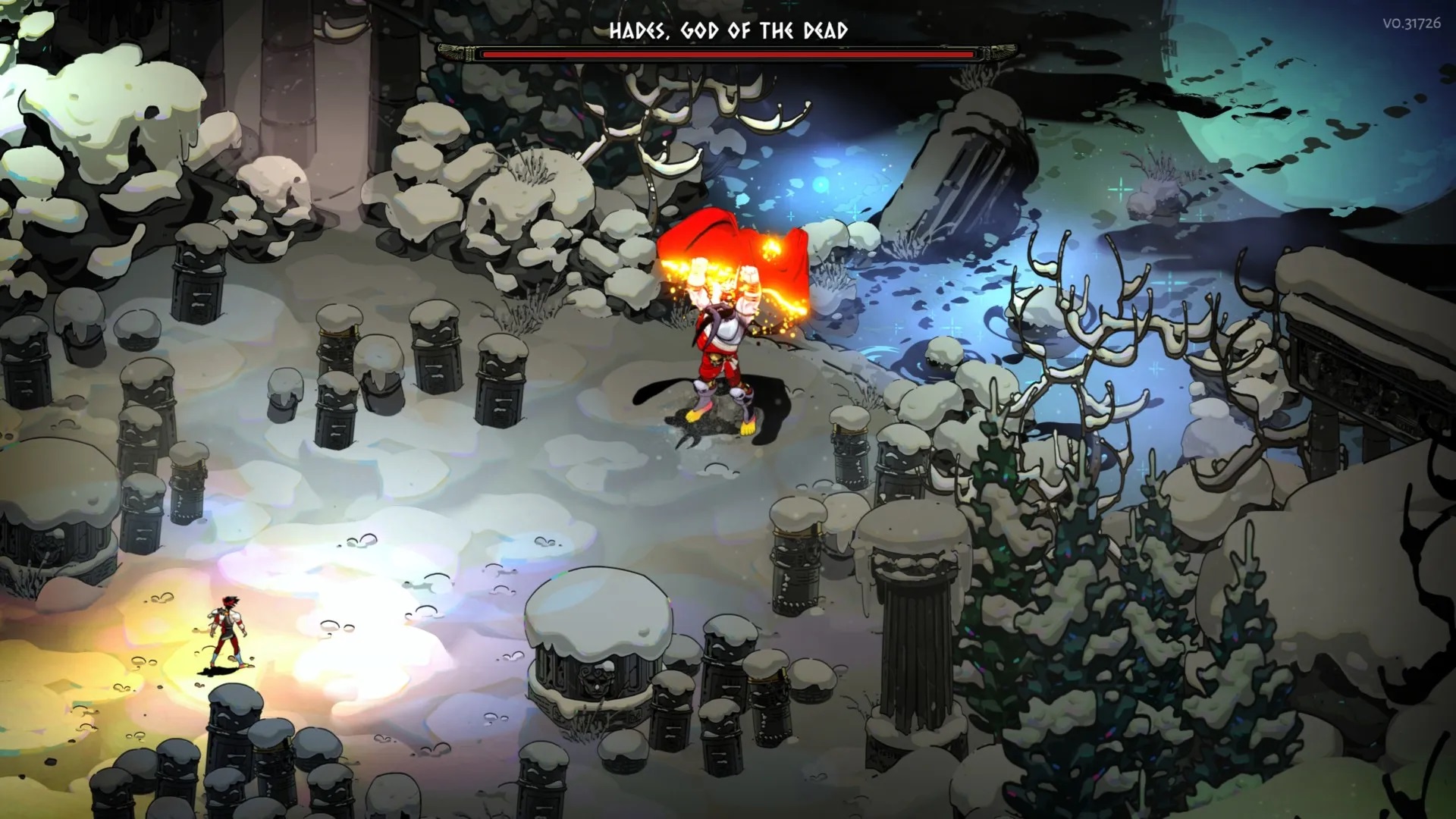
The game is named after him and everything moves toward that moment. You only get to progress by defeating him several times.
He constantly taunts you and he’s the only one preventing Zagreus from escaping—of course you want to fight him.
2. Consider its presentation and look
Sometimes, a badass presentation is all you need to make the boss live forever in your players’ minds.
Here, I remember the Darkside from Kingdom Hearts. He’s just a tutorial boss; pretty easy, in fact. But his presentation is stunning:

I remember seeing it for the first time. The music, how he emerges from Sora’s shadow. I thought, “No way I’m fighting that with this toy sword!”
The Mantis Lords fight from Hollow Knight is also unforgettable. Just after you finish exploring the Mantis Village, which is already a tough area, you find the three of them in their thrones:
Knowing that the game is fairly challenging, you might think there’s no way you’ll have to fight all three at once, but…you sure do. It’s one of the most emblematic boss fights in recent years.
But of course, no discussion of boss presentation would be complete without…well, any boss in Shadow of the Colossus, but this one stands out both for the atmosphere of the fight and the way it pushes you to use all of your tools:
3. Use unexpected escalation
When you start fighting a boss, you might already expect there to be multiple phases. But you’ll never forget the times when a boss surprises you in this area.
I played Final Fantasy XVI last year, and the boss fights throughout the game are a delight. However, there’s one that will be stuck in my head forever: Titan.
Titan is a gigantic eikon, which already makes it pretty impressive to look at. But the boss fight is a continuous escalation:
I remember thinking, “There’s no way there’s more than this”—but it always had even more phases. I don’t know how much money Square put into this, but the result was mind blowing.
4. Work within any metanarratives
This one is tricky. You can’t design a metanarrative, but you can give your game systems that help with creating one.
I think multiplayer games tend to get into these situations more easily. My favorite personal example is fighting Arthas in World of Warcraft.
My friends and I started playing WoW in Wrath of the Lich King. Arthas is a very important character in Warcraft lore, and you can tell he’s the final boss just by looking at him:

After some weeks playing the Ice Crown Citadel raid, we finally reached him, and…got wiped out a lot.
At 3AM, the raid leader said “OK guys, last try, we’ll have to get here again next week”…we were very tense, but that last time was perfect, and we won.
It felt incredible to finally beat the boss together after working at it for so many hours. This is still one of my favorite moments playing video games.
5. Throw in an unexpected twist
Those genuinely surprising moments that make the player say “No way!” are just beautiful.
We worked on this for the Jarvan and Shyvana fight in The Mageseeker. We really wanted a double boss fight in the game, and these two champions were perfect for each other—he’s the future king of Demacia, and she’s his bodyguard who can transform into a dragon.
We knew League lore geeks would expect this moment: the fight starts with just Jarvan, but in the middle of the battle, you see the shadow of a dragon fly overhead (some streamers playing said “Shyvana?!” at this moment):
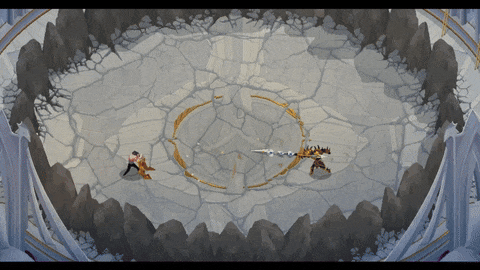
Then, she descends, and you have to fight them both at the same time.
Once you think you’ve defeated them, the second twist comes: Shyvana transforms into a huge dragon and you have to fight her while Jarvan is supporting her.
Phase 3 of this fight is the biggest boss in the game:
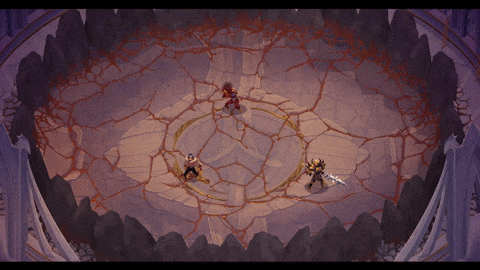
The player hasn’t fought anything this size before in The Mageseeker, so it’s a shocking moment. We put a lot of work into this boss fight, but seeing the players’ reactions made it all worth it.
Another example is Camtscha, The Bleached King from Another Crab’s Treasure. He’s massive, but surprisingly easy compared with the other bosses in the game.
Just when you think you’ve defeated him, he resurrects and becomes much more challenging:
This is a twist, but it doesn’t feel random. There are enemies in that area that do exactly the same thing, so this twist in the boss fight felt more like a perfect conclusion to that area.
6. Break some rules
Be very careful with this one. Don’t break the rules of your game for no good reason!
If you’re making a game where blocking attacks is the core mechanic, that doesn’t automatically mean there needs to be a boss that ignores the player’s blocking ability. First, make sure this doesn’t break any other game mechanics, fits with the overall narrative, and so on.
Tears of the Kingdom breaks its UI as a clever way of showing how overpowered Ganondorf is:

In The Mageseeker, the core mechanic is copying abilities from magical enemies. During the Morgana boss fight, we allowed players to try to copy her ability, but she casts a shield on herself and gains some health:
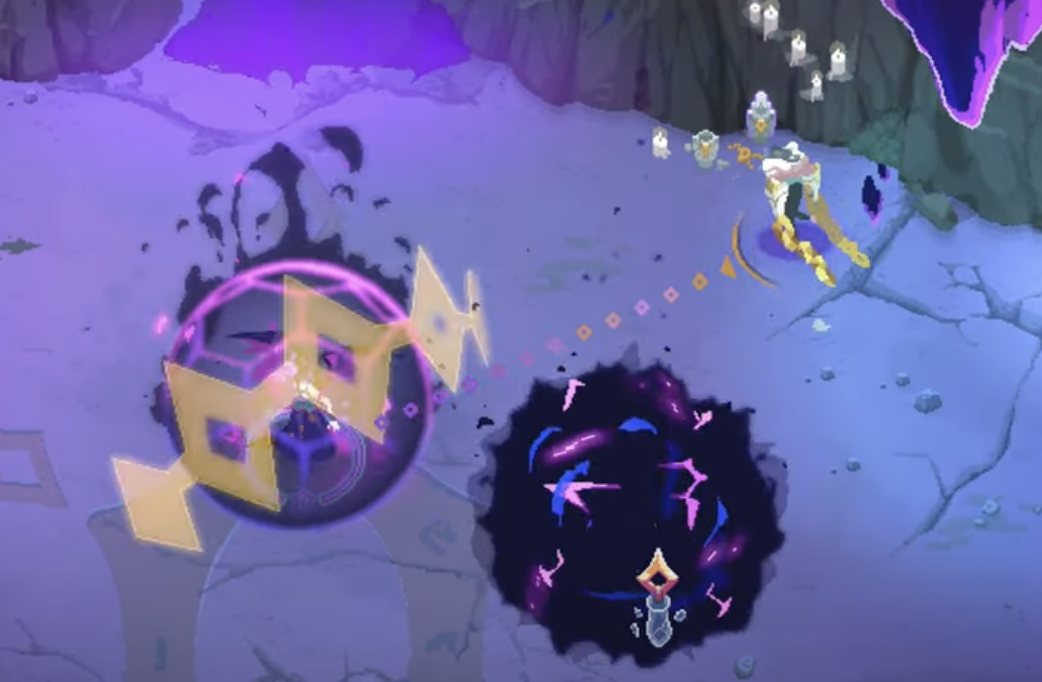
Morgana is a semi-goddess, and we wanted the player to really feel that she’s much more powerful than them.
7. Use the environment
The environment doesn’t have to be a core part of every boss fight, but it’s another key tool you can use!
Sometimes, the environment is impressive enough by itself to leave an impression—like in The Nameless King battle in Dark Souls 3:
But you can also make the environment an active part of the boss fight.
For instance, with the King of the Swamp in Death’s Door, the battle takes place on destroyable platforms, so the player has to deal with the boss’ attacks while watching which platforms are being destroyed:
Pushing this concept even more, the environment can also be the boss itself.
Escape stages are one example of this. I’m not a fan of these. I get pretty nervous and fail a lot.
However, one of my favorite parts of Ori and the Blind Forest was escaping from the Ginso Tree (the main reason was the music):
8. Add epic boss music
Speaking of which—music can elevate any boss fight!
Just try fighting a boss you know you enjoy with the music turned off. It feels so…empty.
The theme of the Ginso Tree escape helped make that one of my favorite moments in Ori, but the best example here, I think, is Sephiroth from Final Fantasy 7.
Sephiroth has a very well-known theme that anyone who has fought him will recognize from just the first few notes:
Use boss archetypes as your starting point
If you don’t have experience designing bosses, one structured way to start is to recognize common boss archetypes and customize them to make them your own.
Here are some of the most popular boss fight tropes:
Resurrecting boss
There are plenty of bosses that, once you think you’ve defeated them, refill their whole health bar and jump into a new phase.
(This also highlights how you can use the UI to communicate with players—the presence of a health bar is usually the clearest indicator that they’re even in a boss fight.)
The Guardian Ape in Sekiro throws off many first-time players when it loses its head, then gets up and continues attacking you:
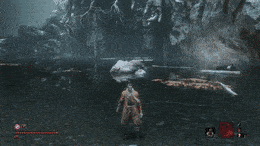
Most games with bosses have at least one of these—and they work. The risk with this trick is that using it too often or in unjustified scenarios can just make it feel cheap.
Boss that comes back later
A variant of the previous one is a boss that runs away after being defeated, only to show up again later in the game.
Recently, I’ve been playing the new World of Warcraft expansion, The War Within. Rasha’nan is the final boss of a dungeon who escapes with half his health, and later, he’s a boss in the raid that starts at 60% health:

It’s a smart way to connect the two fights to each other and make players feel like their actions have an impact.
This also helps demonstrate progression to the player. Many games start with a nearly impossible boss fight so that the player can face them again later and overcome their nemesis.
Boss made to defeat you
Keep in mind that these level-up-and-rematch bosses should be justified by the narrative.
We did this with Garen in The Mageseeker—we wanted to show how powerful he is (and have a strong opening for the game!), so you have to fight him (and lose) after just a few minutes of gameplay. Then, when you’re much stronger in the later refight, you get to beat him up.
Another example is Genichiro in Sekiro, with this memorable introduction:

You have to fight him quite early. It’s really hard to defeat him (but not impossible!)—you’re supposed to lose here so you can defeat him much later in the game, proving your growth and mastery of its mechanics.
Boss with adds
Another way to add variability is to have the boss call in reinforcements. Summoning new enemies immediately adds several unique elements to the boss fight.
- How often do they spawn?
- Are there different phases of adds?
- Are they regular enemies, or unique ones that only appear with this boss?
- What happens when players attack the main boss directly?
- What does the main boss do when players target the smaller enemies?
- Is the goal still to deplete the main boss’ health, or are there secondary win conditions?
As with the resurrecting archetype, bosses that spawn adds appear in numerous games and play with this concept in as many ways. Take the Grey Crow in Death’s Door. This boss has predictable moves but adds prevent the player from focusing too much on the boss.
They can even be used to deal damage to the boss, which is a smart mechanic.
Double boss
Double bosses are hard to make, but feel awesome when they’re done correctly.
You want both bosses to work together against the player, but not overwhelm them.
The best reference for this is, with no discussion, Orstein and Smough from Dark Souls. Orstein is fast and attacks from a distance, while Smough is slow but really dangerous up close:
Managing these two at the same time is deeply challenging, but somehow, it gets even worse once you defeat one of them.
Logic dictates that the fight should get easier with half as many opponents—but boss fights usually scale up, not down. Instead, the remaining boss gets extremely powerful, and the battle continues while becoming even harder.
Watch out for these common boss design errors
No matter how hard you and your team work on creating an unbelievable boss fight, there are certain mistakes that can destroy the whole experience.
Here are some of the most common boss design errors I’ve seen (and made):
The boss is too easy or too difficult
Bosses are supposed to be a challenge, but it’s a balancing act. If a game is too easy, players get bored. If it’s too hard, they get frustrated.
This also applies to pretty much any aspect of a game, and it can be explained through flow theory—the goal is always to find the game flow state between frustration and boredom:

Likewise, if the boss feels unfair, people will probably quit playing. Don’t be mean to your players!
For example, the optional Odin boss fight in Final Fantasy VII Rebirth has a unique gimmick (on top of being harder than the mandatory content)—if the player fails to avoid several attacks, Odin gets bored and just kills them:
While this is creative, most people I know thought it seemed unfair, since they didn’t think they were playing badly. They felt like they just had to repeat it over and over, crossing their fingers not to annoy Odin.
You need to find the sweet spot. Players will come to your game with different expectations and preferences, so knowing your target audience is the key to balancing your bosses properly.
For instance, FromSoftware games may be frustrating to many people, but their level of difficulty is usually just right for their target audience.
Elden Ring’s achievement stats show that over half its players defeated the final story boss, and 1/3 even took down the two hidden, especially difficult optional ones.
This can only be achieved through many playtests and balance adjustments.
All boss attacks can be avoided the same way
Great—you’ve perfectly balanced your boss fight! However, if you didn’t have the player’s moveset in mind while designing it, you may find that they can respond to all the boss’ attacks in the same way.
This means they don’t have to learn the boss’ patterns; no matter what attack is coming next, they can just dash/roll/spindash? away to safety.
Thankfully, this problem can be prevented easily if you address it from the beginning by adjusting some attacks’ direction, timing or range. (Don’t wait until the boss has been produced, or you might need to redo part of the fight.)
The boss is too repetitive
Let’s say your boss is well-balanced and has a healthy variety of attacks—but after a minute or so, your players start to get bored.
This is probably because they got used to the boss. Its patterns are too repetitive.
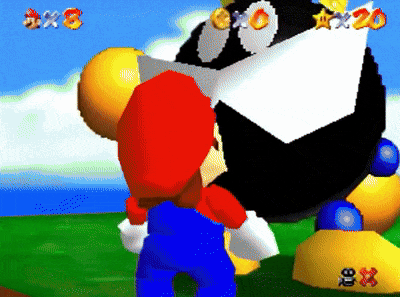
There are a few easy ways to solve this, such as adding some unpredictability to its movement, varying how often it uses certain moves (or in which order), and escalating the boss’ attacks during the fight.
It can also happen when you have several similar-feeling bosses. This is a much more difficult problem to solve, so be sure to keep each of your bosses in mind when designing a new one.
The boss is too hard to understand
Sometimes, as a designer, you want to follow your dream and make something that’s never been seen before. So you design a unique, game-changing new mechanic, but…no one understands it.
It’s great being innovative, but never forget that you’re doing this for your players. The goal is for them to have fun!
And misunderstanding your players’ perspective isn’t exclusive to innovative bosses. Any boss with at least one attack that’s not well presented will suffer from this.
You didn’t playtest and iterate enough
All bosses need iterations! Your design might seem perfect, but chances are, there are still a few ways to improve upon it that a playtest would help illuminate.
You need to watch people play your bosses, listen to what they like and dislike most, and then iterate. It’s usually obvious to players when you don’t playtest the game properly before releasing it:
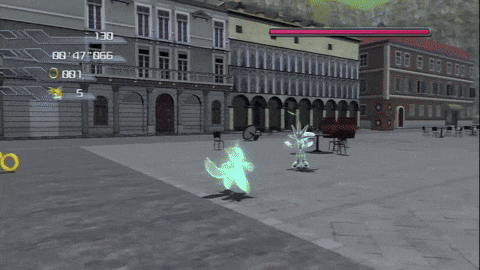
The sooner you do this, the more iterations you’ll be able to make, and the more your boss’ design will improve.
I’m thankful that we could do several iterations of each boss in The Mageseeker. In some cases, it took just a couple of iterations to get it right, but others took 5 or 6 tries—normally because I made mistakes in the core design of the boss.
To resolve these mistakes, you first need to know they exist. And one of the best ways to find them is through playtests.
You were too ambitious
Boss battles are probably my favorite thing in video games (both as a designer and as a player), but they also tend to be expensive. Really expensive.
To avoid getting into development hell, the first step is to determine why your game needs this particular boss.
The whole team is going to work together to build this brief but memorable moment, so save your boss fights for the most climactic and important parts, and design them around your team’s work capacity and experience.
2 Examples of boss design in The Mageseeker
To be a bit more clear about our approach to boss design, I’ll talk about two examples in The Mageseeker:


The first is Morgana, a League champion, which is a boss fight we designed for an already created character.
The second is Sylas’s Nightmare, an original character in The Mageseeker that we had to design from scratch.
1. Morgana
Purpose: Morgana is one of the most popular champions in League of Legends. As with every champion, our main purpose was always to show the real power scale of these characters, ignoring the limitations of the MOBA.
Here is an example of the Morgana boss fight:
Also, Morgana is a semi-goddess. We wanted players to feel that she’s much more powerful than Sylas and she’s just playing with him.
Theme: Since Morgana was a licensed character, we didn’t have to work much on this and focused on figuring out what moves she could do in an ARPG.
Moveset: With every League champion, we tried to be loyal to how they feel in the MOBA, but we also made sure Morgana pushed the limits of her abilities.
She’s famous in League for her combo Q+W, where she roots a player for many seconds then casts an area that deals damage over time. In Mageseeker, when she roots the player, she casts her area immediately and laughs.
Additionally, since she has her wings chained, we created a new attack where she breaks the chains temporarily to fly to the center of the room and cast rain over many areas (essentially a small version of her League ability):
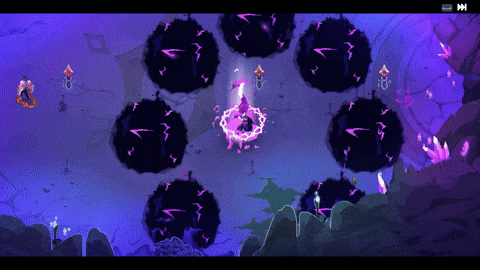
The chains are quite noticeable thanks to Sylas, so unchaining Morgana for a big attack felt appropriate.
Escalation: As said, the main purpose of this boss was to show Morgana’s true power. We did this through escalation.
In her first phase, she only uses her League abilities (except her ultimate): Dark Binding to root Sylas, Tormented Shadow to deal AoE damage over time and deny part of the arena to the player, and Black Shield to avoid players copying her abilities.
As the second phase starts, she uses her ultimate, where she chains Sylas and tries to stun him. This is only avoidable if the player uses Sylas’s chain hook to evade her.
Additionally, we “broke” Dark Binding and Tormented Shadow by making her able to cast multiple instances of them at the same time:
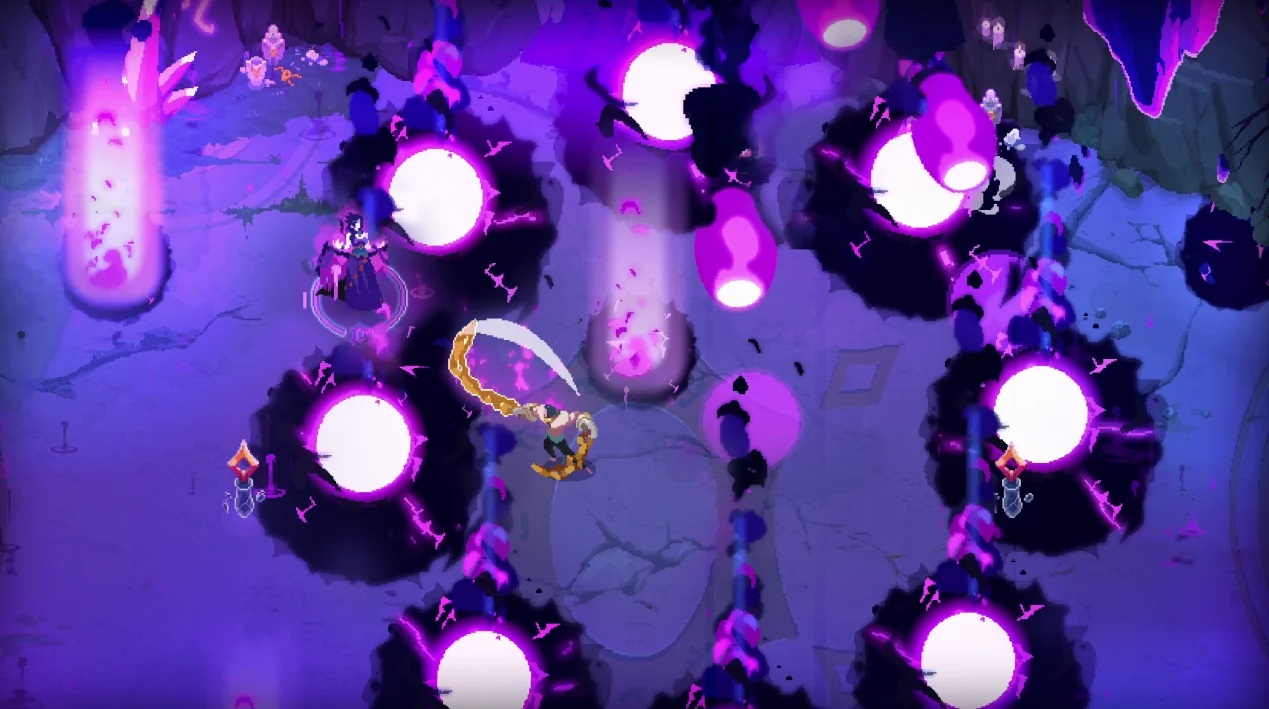
Finally, when the third phase arrives, she flies and invokes a rain that hits many small areas—while continuing to use her other abilities. The player now needs to be extremely conscious of the little space they have left.
Issue #1: Morgana’s tells were difficult to distinguish from each other, since she’s a humanoid and all her abilities are ranged.
At first, it was hard to tell the difference between Dark Binding and Tormented shadow. We didn’t want her animations to be too different from League, so we addressed this problem with two adjustments:
- We increased the tell time and reduced her cooldowns.
- We wanted to give players more time to read her while maintaining the pacing of the fight (and her aggression), so we also reduced her cooldowns.
- We made the casting FX of the ability more obvious.
- Morgana’s animations look similar, but one is a projectile while the other affects an area. So, we exaggerated the FX of Tormented Shadow to show it falling from above the player, and made a big sphere appear in Morgana’s hands with Dark Binding.
Issue #2: Morgana was too predictable.
We didn’t make many different attacks for Morgana since we were focused on the scalability of her League abilities, and players got used to her abilities too quickly. They could simply deal damage until her animation changes, run until that attack ends, and repeat.
We realized that the fight needed some base threat apart from Morgana attacking, so we made two tweaks:
- We increased the duration of her area attacks.
- This made players more cautious around them, both during casting and for several seconds afterward. They now had to avoid these areas while dodging Morgana’s other attacks.
- We made a small iteration to her rain in the last phase.
- At first, she just floated in the air while casting, and players could easily avoid the small areas. So, we increased the areas’ duration and we made her go back to the ground immediately to continue her onslaught on top of the rain, making the fight much less predictable.
2. Sylas’s Nightmare
Purpose: The player fights Sylas’s Nightmare twice, and the first time is meant to be a skill test. We wanted to test if the player could use both the dash and chains to avoid attacks:
The second fight mainly has a narrative purpose. This character is a representation of Sylas’s traumas and fears, so she appears as Lux, a friend Sylas regrets having betrayed—then reveals herself as the Nightmare:
Theme: Sylas was recruited by the Mageseekers and then imprisoned by them for 15 years. His Nightmare represents his deepest fear, so we decided to give it the Mageseeker’s outfit and chains as extremities.
The Nightmare is created by another mage, Rayn, who can enter Sylas’s head. This whole fight is happening inside Sylas’s head, so everything has an oneiric look. Her music theme is even an altered version of Sylas’s theme.
Moveset: Almost all of her attacks are based on the use of the chains.
Since we wanted to force the player to use both the dash and the chain hook, the whole fight is based on two attacks that are avoided differently:
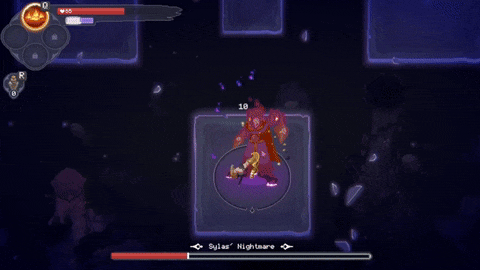
To add some variance, we included an interphase where Sylas has to travel around different platforms avoiding attacks.
In the second fight, where she’s presenting herself as Lux, she uses a dark version of Lux’s ultimate. We gave her a couple more abilities and broke her chains for the last phase.
Escalation: The first fight has a simple escalation, where attacks are just sped up and repeated several times. Here, our main goal was to test the player’s avoidance skill, so that was all we needed.
For the second fight, we know players usually don’t love to repeat bosses and we really wanted to play with those expectations. So, the beginning is just like the first fight, but it’s only about 15% of the whole battle.
Next, she moves away and the player has to travel around platforms while avoiding Nightmare’s version of Lux’s ultimate. In the second phase, the player fights on one big platform, with more space to avoid the now increasingly aggressive Nightmare:
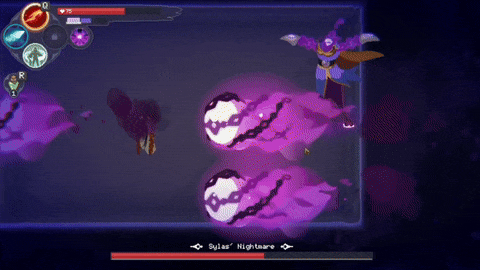
Finally, the last phase starts, with Nightmare breaking the area into six small platforms. She continues attacking and can now destroy some platforms, so players need to be constantly aware of the environment to avoid falling while looking for an attack window.
Issue #1: The fight was frustrating.
The two fights had this issue in different ways.
- For the first fight, Sylas’s moveset wasn’t smooth enough.
- This is one of the first bosses we created; players could fall easily when dashing and found hookables hard to target. The fight got better as we kept polishing Sylas’s moveset over the 4 years of development.
- In the second fight, one attack was too frustrating and drawn-out.
- When the boss would move around platforms while shooting at Sylas, it was almost impossible to deal damage, and avoiding attacks for that long isn’t fun. We iterated so that Nightmare would just teleport and attack three times (still intense, but much quicker).
Issue #2: Players didn’t understand what they were supposed to do.
- For the first fight, players didn’t understand how to avoid her whirl attack.
- It looks dashable, to be honest, but has to be avoided by moving away from the platform. We tinted the whole platform during the boss tell to make this clearer, which was extremely effective.
- In the second fight’s second phase, players would misread an opportunity to attack.
- When the Nightmare goes to one extreme of the platform and shoots projectiles, players thought it was safe to deal damage, but usually died instead. We reduced Nightmare’s received damage during this attack to discourage players from getting close to her.
Final thoughts
To sum everything up—every boss has these elements:
- Anticipation
- Presentation
- The Fight
- A Conclusion
When designing a boss, you need to define its:
- Purpose
- Theme
- Mechanics
- Escalation
If I had to distill all of this down to a few pieces of advice, they would be:
- Don’t rush. Make sure you have everything you need before putting the effort into a boss fight.
- Playtest—a lot. It can be painful when your boss isn’t as fun as you expected, but it’s better to notice this during development than after release.
- Pay attention to common errors. Most are easy to avoid if you keep them in mind, but hard to resolve later in production.
- Make sure you need a boss fight. Boss fights are expensive, hard to design, and only last a few minutes, so make sure it’s all worth it!










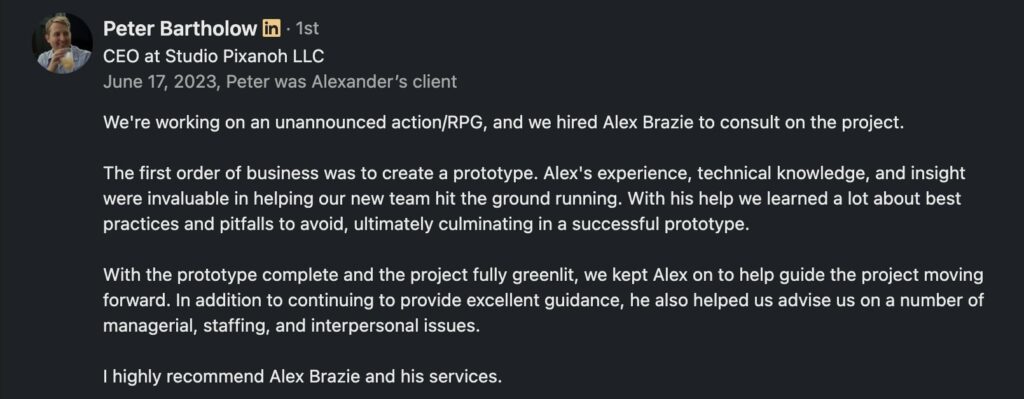

One Response
Hello! This is an extremely well written article. I’ll be sure to bookmark it and return to read more of your useful info. Thanks for the post. I will definitely return.